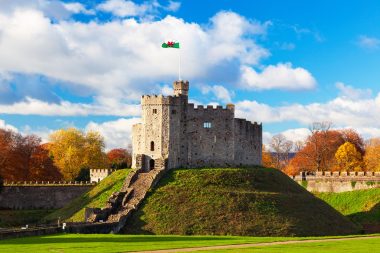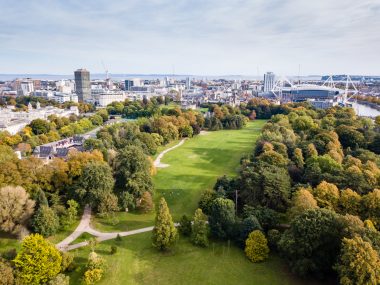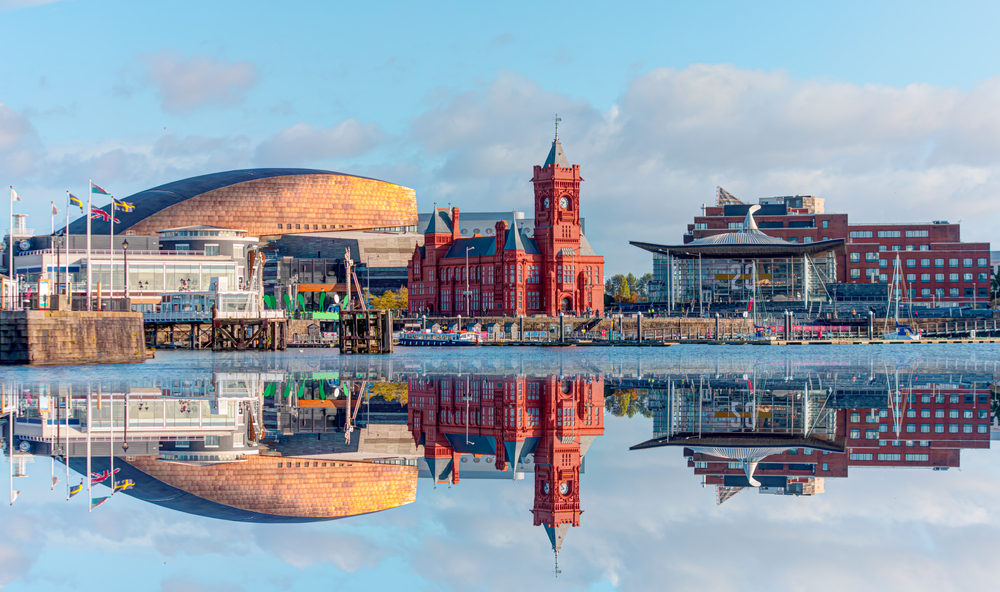Wales is located in the southwest of Great Britain and you might think that time has stood still. It is known for its enchanting natural landscapes, countless hills and valleys, rugged coastlines, a total of three national parks, its historic buildings, its Celtic culture, its special Welsh language and the hospitality of the people. The clocks seem to tick more slowly in Wales, the serenity is also noticeable in big cities. The capital Cardiff is located in the south of Wales, is a beautiful coastal city and is full of surprises.
Cardiff – Sightseeing
The National Museum Cardiff is home to one of the most important art collections in Europe. Countless impressionists and surrealists as well as Welsh artists of the 20th century are represented with their works of art. There are also natural history, geological and archaeological exhibitions to marvel at in the museum. Another highlight is the Wales Millennium Centre, which opened in 2004 and is the venue of the Welsh National Opera. The opera is composed of the National Orchestra of Wales and the National Dance Company. The Wales Millennium Centre hosts musicals, theatre performances, operas, concerts, ballet performances and various events. This arts centre was built from local Welsh materials, such as wood from sustainable forestry, and slate. The Chapter Arts Centre, which was founded in 1971 through various fundraising campaigns, offers space for countless events and also cinema screenings. Also a must-see is Cardiff Castle, which was founded by the Romans in the 1st century, was expanded into a strong fortress by the Normans in the 11th century, the main tower from this time, “The keep”, is located in the keep of today’s castle.

In the 18th century, under the third Marquis of Bute and William Burges, the magnificent castle was expanded into a fascinating fairytale castle in the neo-Gothic style. The St. Fagans National History Museum is located on the outskirts of Cardiff. 40 buildings such as farmhouses, small shops, a pub, a mill and a bakery have been rebuilt and show insights into the simple life of times gone by. There is the opportunity to watch various artisans at work. You can also visit St Fagans Castle, a 16th-century manor house, the House of the Future with exhibitions on the language and history of Wales, a charming 12th-century church and the beautiful gardens.
The Taff Trail, is a popular hiking and biking trail of 89 km in length. It stretches from Cardiff Bay, following the River Taff, through the city. Then through the 800 hectare Bute Park to the Brecon Beacons National Park. Cardiff International White Water offers opportunities for adventurous water sports activities.
Another attraction is the famous Principality Stadium. Here in the city centre, international rugby and football matches, various other sporting events and also live music concerts take place regularly. Also in the center is the town hall, which harmoniously combines French and English Renaissance.
The 194 m high bell tower is a striking symbol of this district. The University of Wales is the largest university in Wales. Just outside the city is the Big Pit, the National Coal Museum of Wales and Caerphilly Castle, the largest castle complex in the country. Cardiff Bay, once the world’s largest coal export port, has now been transformed into a modern district. It is located about 1.2 km south of the city center. There are extravagant bars and pubs, cafés, playgrounds and the possibility of various boat tours.
Facts about Cardiff
- Size: Cardiff is the eleventh largest city in the United Kingdom and covers an area of about 140 square kilometers. The city has grown from a small settlement to one of the most important urban centres in the UK.
- Population: Cardiff has a population of around 366,000 people, with a diverse community that includes many ethnic backgrounds and cultures. This contributes to a lively social and cultural life.
- Languages: English is predominantly spoken in Cardiff, but Welsh is also an official language and is spoken by part of the population. The city actively promotes the learning and use of the Welsh language in schools and public institutions.
- Cultural diversity: Cardiff is known for its multicultural atmosphere. The city celebrates a variety of festivals and events that reflect different cultures and traditions, including the annual Cardiff Festival and the Sŵn Music Festival.
- Historical significance: Cardiff’s history dates back over 2,000 years. Originally a Roman fortress, it developed into one of the largest coal ports in the world in the 19th century. Today, there are many historic sites to explore, including Cardiff Castle, which displays a mix of Roman, Norman and Victorian elements.
- Sports-loving city: Cardiff is a centre for sport in Wales. It is home to the Millennium Stadium (now known as the Principality Stadium), which hosts major rugby and football events, including Rugby World Cup and FA Cup matches.
- Economic centre: Cardiff is the economic powerhouse of Wales and an important location for business, media and science. The city has a growing economy that relies on sectors such as financial services, technology, and tourism.
- University City: Cardiff is also a major university city, with several higher education institutions, including Cardiff University, which is internationally recognized for its research and teaching.
Oases of peace and relaxation

The city of Cardiff can claim to have more green spaces and parks than any other city in the UK. More than 10 percent of the city’s total area is made up of parks. The main park is the so-called Bute Park. It connects the city center with the northwestern part of the city and is characterized by many green spaces. There are many comfortable benches here.
Roath Park is located in the north of the city. The special thing about this park is the romantic river on which you can go boating. The Local Nature Reserve is 130,000 m² in size and is located near the Rhymney Valley in Penylan. This nature reserve is famous for its beautiful, enchanting orchids. Forest Farm Country Park is located on the Taff River in Whitechurch. Another highlight is St. John’s Churchyard Park. The term “small but nice” applies perfectly to it. It is about 1,500 m² in size and is located between St. John’s Church and the Old Library.
Enchanting national parks
Wales has three national parks, all of which can be reached from Cardiff in a day’s journey. The nearest national park to Cardiff is the Brecon Beacons National Park, which can be reached in about an hour’s drive.
The other two national parks, the Pembrokeshire Coast National Park and the Snowdonia National Park, can both be reached from Cardiff in about 2.5 hours. Snowdonia National Park is the oldest of the three national parks. It fascinates with its beautiful hiking trails, spectacular mountain ranges, fairytale waterfalls and lakes. This national park showcases Wales in its most pristine form. A train leads to the summit of the highest mountain in Wales, Snowdon. Its name is made up of the words snow and don, which means snow and mountain.
Cardiff – climate and best time to visit
The climate in Cardiff is temperate, the summers are very mild with averages around 20 degrees Celsius. You always have to expect rain, the best time to travel is in the months of June, July, August and September. These months are also the warmest and those with the least rainfall.


